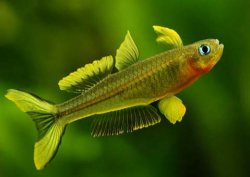Common name/s: Forktail Rainbow <Forktail Blue Eye - The Pseudomugil genus is known throughout much of the world as "Blue Eye" - you will often see them called that in the trade. - LL>
Scientific name: Pseudomugil furcatus
Origin: Papua New Guinea.
Size: 5-6cm./2”
Care: Being very active little fish an aquarium of at least two feet would be suitable. They come from fast flowing streams with a ph of between 7 and 8 and a temperature of between 24 and 26C (75-79F). They appreciate planted tanks as they can zip in and out of the plants and use them for spawning. They are hardy and adaptable to different water conditions. They are best kept in groups of six or more equal numbers of males and females work fine. They are very peaceful and won’t bother other fish they are also fast so can be kept with fish somewhat bigger than themselves.
Feeding: They accept any dry, frozen or live foods appropriate to their size. They feed and live mostly in the upper levels of the tank.
Sexing: Males are bigger, more colourful with longer fins than females (see pics)
Breeding: They are egg-scatterers and will spawn regularly. In my tank some of the babies have survived to adulthood in a community tank due to very dense plant growth. To breed them a small tank with a group can be set up with either one male and a couple of females or a group. The eggs stick to plants so moss or stem plants are useful. The adults need to be removed, as they will eat the eggs. Eggs take about two weeks to hatch at 25C. The tiny fry need infusoria as a first food.
<Most of the Blue Eye's are fairly recently evolved species arising from physical seperation of progenitor populations in their wild environment. As a result, when keeping more then one species, be careful! They readily hybridise producing useless offspring - LL>
Pictures: The first is a male displaying his fins the second a young female.


Scientific name: Pseudomugil furcatus
Origin: Papua New Guinea.
Size: 5-6cm./2”
Care: Being very active little fish an aquarium of at least two feet would be suitable. They come from fast flowing streams with a ph of between 7 and 8 and a temperature of between 24 and 26C (75-79F). They appreciate planted tanks as they can zip in and out of the plants and use them for spawning. They are hardy and adaptable to different water conditions. They are best kept in groups of six or more equal numbers of males and females work fine. They are very peaceful and won’t bother other fish they are also fast so can be kept with fish somewhat bigger than themselves.
Feeding: They accept any dry, frozen or live foods appropriate to their size. They feed and live mostly in the upper levels of the tank.
Sexing: Males are bigger, more colourful with longer fins than females (see pics)
Breeding: They are egg-scatterers and will spawn regularly. In my tank some of the babies have survived to adulthood in a community tank due to very dense plant growth. To breed them a small tank with a group can be set up with either one male and a couple of females or a group. The eggs stick to plants so moss or stem plants are useful. The adults need to be removed, as they will eat the eggs. Eggs take about two weeks to hatch at 25C. The tiny fry need infusoria as a first food.
<Most of the Blue Eye's are fairly recently evolved species arising from physical seperation of progenitor populations in their wild environment. As a result, when keeping more then one species, be careful! They readily hybridise producing useless offspring - LL>
Pictures: The first is a male displaying his fins the second a young female.


